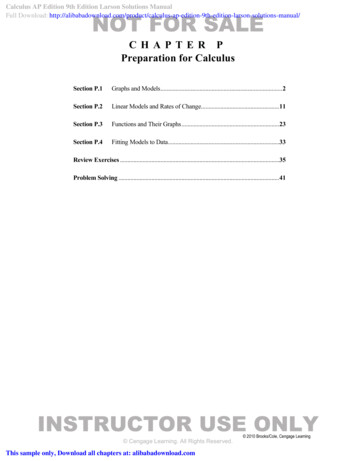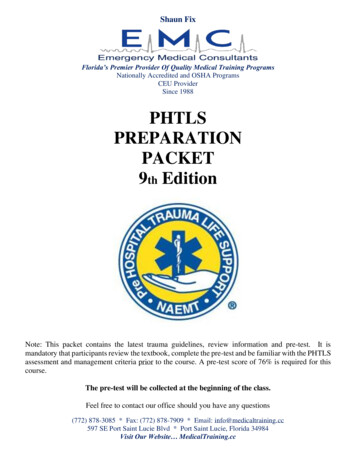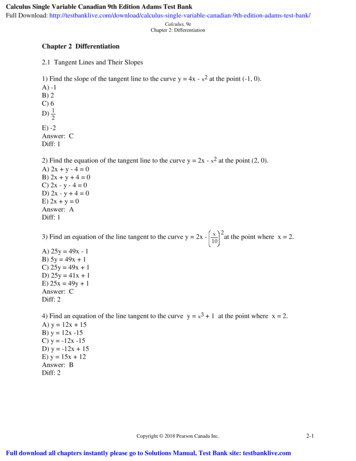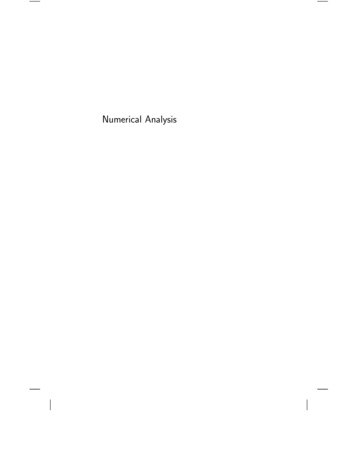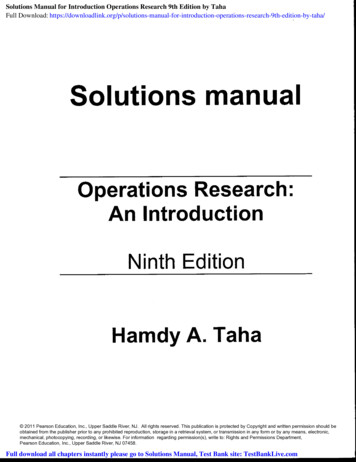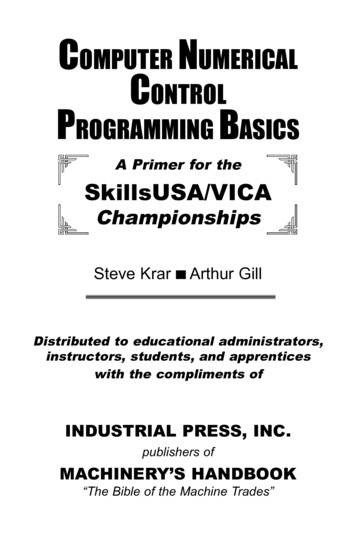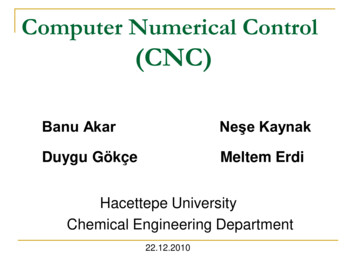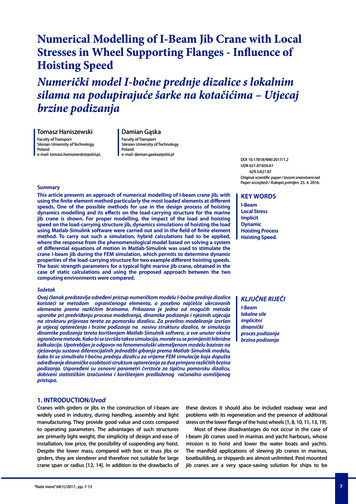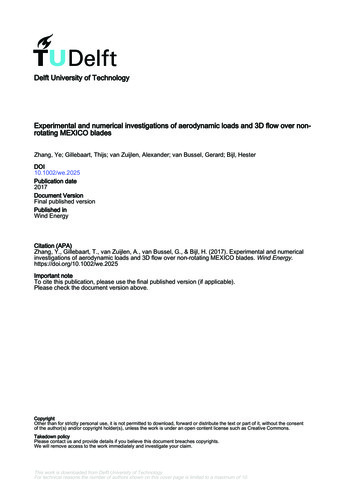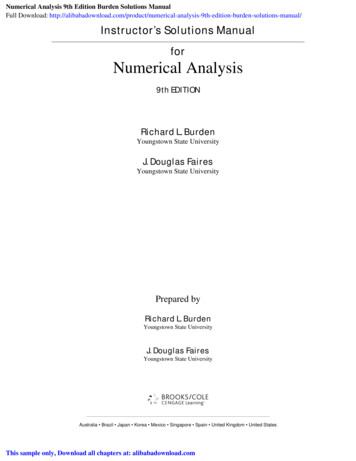
Transcription
Numerical Analysis 9th Edition Burden Solutions ManualFull Download: ’s Solutions ManualforNumerical Analysis9th EDITIONRichard L. BurdenYoungstown State UniversityJ. Douglas FairesYoungstown State UniversityPrepared byRichard L. BurdenYoungstown State UniversityJ. Douglas FairesYoungstown State UniversityAustralia Brazil Japan Korea Mexico Singapore Spain United Kingdom United StatesThis sample only, Download all chapters at: alibabadownload.com
ISBN-13: 978-0-538-73596-4ISBN-10: 0-538-73596-1 2011 Brooks/Cole, Cengage LearningALL RIGHTS RESERVED. No part of this work covered by thecopyright herein may be reproduced, transmitted, stored, orused in any form or by any means graphic, electronic, ormechanical, including but not limited to photocopying,recording, scanning, digitizing, taping, Web distribution,information networks, or information storage and retrievalsystems, except as permitted under Section 107 or 108 of the1976 United States Copyright Act, without the prior writtenpermission of the publisher except as may be permitted by thelicense terms below.For product information and technology assistance, contact us atCengage Learning Customer & Sales Support,1-800-354-9706For permission to use material from this text or product, submitall requests online at www.cengage.com/permissionsFurther permissions questions can be emailed topermissionrequest@cengage.comBrooks/Cole20 Channel Center StreetBoston, MA 02210USACengage Learning is a leading provider of customizedlearning solutions with office locations around the globe,including Singapore, the United Kingdom, Australia,Mexico, Brazil, and Japan. Locate your local office at:international.cengage.com/regionCengage Learning products are represented inCanada by Nelson Education, Ltd.For your course and learning solutions, visitacademic.cengage.comPurchase any of our products at your local collegestore or at our preferred online storewww.ichapters.comNOTE: UNDER NO CIRCUMSTANCES MAY THIS MATERIAL OR ANY PORTION THEREOF BE SOLD, LICENSED, AUCTIONED,OR OTHERWISE REDISTRIBUTED EXCEPT AS MAY BE PERMITTED BY THE LICENSE TERMS HEREIN.READ IMPORTANT LICENSE INFORMATIONDear Professor or Other Supplement Recipient:Cengage Learning has provided you with this product (the“Supplement”) for your review and, to the extent that you adoptthe associated textbook for use in connection with your course(the “Course”), you and your students who purchase thetextbook may use the Supplement as described below. CengageLearning has established these use limitations in response toconcerns raised by authors, professors, and other usersregarding the pedagogical problems stemming from unlimiteddistribution of Supplements.Cengage Learning hereby grants you a nontransferable licenseto use the Supplement in connection with the Course, subject tothe following conditions. The Supplement is for your personal,noncommercial use only and may not be reproduced, postedelectronically or distributed, except that portions of theSupplement may be provided to your students IN PRINT FORMONLY in connection with your instruction of the Course, so longas such students are advised that theyPrinted in the United States of America1 2 3 4 5 6 7 11 10 09 08 07may not copy or distribute any portion of the Supplement to anythird party. You may not sell, license, auction, or otherwiseredistribute the Supplement in any form. We ask that you takereasonable steps to protect the Supplement from unauthorizeduse, reproduction, or distribution. Your use of the Supplementindicates your acceptance of the conditions set forth in thisAgreement. If you do not accept these conditions, you mustreturn the Supplement unused within 30 days of receipt.All rights (including without limitation, copyrights, patents, andtrade secrets) in the Supplement are and will remain the sole andexclusive property of Cengage Learning and/or its licensors. TheSupplement is furnished by Cengage Learning on an “as is” basiswithout any warranties, express or implied. This Agreement willbe governed by and construed pursuant to the laws of the Stateof New York, without regard to such State’s conflict of law rules.Thank you for your assistance in helping to safeguard the integrityof the content contained in this Supplement. We trust you find theSupplement a useful teaching tool.
Table of ContentsPrefaceviiMathematical PreliminariesExercise Set 1.1 . . . . . . . . . . . . . . . . . . . . . . . . . . . . . . . . . . . . . . . . . .Exercise Set 1.2 . . . . . . . . . . . . . . . . . . . . . . . . . . . . . . . . . . . . . . . . . .Exercise Set 1.3 . . . . . . . . . . . . . . . . . . . . . . . . . . . . . . . . . . . . . . . . . .11612Solutions of Equations of One VariableExercise Set 2.1 . . . . . . . . . . . . . . .Exercise Set 2.2 . . . . . . . . . . . . . . .Exercise Set 2.3 . . . . . . . . . . . . . . .Exercise Set 2.4 . . . . . . . . . . . . . . .Exercise Set 2.5 . . . . . . . . . . . . . . .Exercise Set 2.6 . . . . . . . . . . . . . . .19192226313436Interpolation and Polynomial ApproximationExercise Set 3.1 . . . . . . . . . . . . . . . . . . .Exercise Set 3.2 . . . . . . . . . . . . . . . . . . .Exercise Set 3.3 . . . . . . . . . . . . . . . . . . .Exercise Set 3.4 . . . . . . . . . . . . . . . . . . .Exercise Set 3.5 . . . . . . . . . . . . . . . . . . .Exercise Set 3.6 . . . . . . . . . . . . . . . . . . .41414749525668Numerical DifferentiationExercise Set 4.1 . . . . . .Exercise Set 4.2 . . . . . .Exercise Set 4.3 . . . . . .Exercise Set 4.4 . . . . . .Exercise Set 4.5 . . . . . .Exercise Set 4.6 . . . . . .Exercise Set 4.7 . . . . . .Exercise Set 4.8 . . . . . .Exercise Set 4.9 . . . . . .71. 71. 78. 82. 87. 91. 94. 96. 99. 101.and Integration. . . . . . . . . . . . . . . . . . . . . . . . . . . . . . . . . . . . . . . . . . . . . . . . . . . . . . . . . . . . . . . . . . . . . . . . . . . . . . . . . . . . . . . . . . .iii.
ivInitial-Value ProblemsExercise Set 5.1 . . . .Exercise Set 5.2 . . . .Exercise Set 5.3 . . . .Exercise Set 5.4 . . . .Exercise Set 5.5 . . . .Exercise Set 5.6 . . . .Exercise Set 5.7 . . . .Exercise Set 5.8 . . . .Exercise Set 5.9 . . . .Exercise Set 5.10 . . .for. . . . . . . . . . .Ordinary Differential Equations. . . . . . . . . . . . . . . . . . . . . . . . . . . . . . . . . . . . . . . . . . . . . . . . . . . . . . . . . . . . . . . . . . . . . . . . . . . . . . . . . . . . . . . . . . . . . . . . . . . . . . . . . . . . . . . . . . . . . . . . . . . . . . . . . . . . . . . . . . . . . . . . . . . . . . . . . . . . . . . . . . . . . . . . . . . . . . . . . . . . . . . . . . . . . . . . . . . . . . . . .Direct Methods for SolvingExercise Set 6.1 . . . . . . .Exercise Set 6.2 . . . . . . .Exercise Set 6.3 . . . . . . .Exercise Set 6.4 . . . . . . .Exercise Set 6.1 . . . . . . .Exercise Set 6.6 . . . . . . .Linear Systems. . . . . . . . . . . . . . . . . . . . . . . . . . . . . . . . . . . . . . . . . . . . . . . . . . . . . . . . . . . . 190194Iterative Techniques inExercise Set 7.1 . . . .Exercise Set 7.2 . . . .Exercise Set 7.3 . . . .Exercise Set 7.4 . . . .Exercise Set 7.5 . . . .Exercise Set 7.6 . . . .Matrix. . . . . . . . . . . . . . . . . . . . . . . . .Algebra. . . . . . . . . . . . . . . . . . . . . . . . . . . . . . .201201206209215219221Approximation TheoryExercise Set 8.1 . . . .Exercise Set 8.2 . . . .Exercise Set 8.3 . . . .Exercise Set 8.4 . . . .Exercise Set 8.5 . . . .Exercise Set 8.6 . . . .231231232236238244247Approximating EigenvaluesExercise Set 9.1 . . . . . . .Exercise Set 9.2 . . . . . . .Exercise Set 9.3 . . . . . . .Exercise Set 9.4 . . . . . . .Exercise Set 9.5 . . . . . . .Exercise Set 9.6 . . . . . . .251251257262266267273.
vNumerical Solutions ofExercise Set 10.1 . . .Exercise Set 10.2 . . .Exercise Set 10.3 . . .Exercise Set 10.4 . . .Exercise Set 10.5 . . .Nonlinear. . . . . . . . . . . . . . . . . . . . . . . . . . . . . . .Systems of Equations. . . . . . . . . . . . . . . . . . . . . . . . . . . . . . . . . . . . . . . . . . . . . . . . . . . . . . . . . . . . . . . . . . . . . . .Boundary-Value Problems for OrdinaryExercise Set 11.1 . . . . . . . . . . . . . .Exercise Set 11.2 . . . . . . . . . . . . . .Exercise Set 11.3 . . . . . . . . . . . . . .Exercise Set 11.4 . . . . . . . . . . . . . .Exercise Set 11.5 . . . . . . . . . . . . . .Numerical Solutions toExercise Set 12.1 . . .Exercise Set 12.2 . . .Exercise Set 12.3 . . .Exercise Set 12.4 . . .Partial. . . . . . . . . . . . . . . . .281281284287290291Differential Equations. . . . . . . . . . . . . . . . . . . . . . . . . . . . . . . . . . . . . . . . . . . . . . . . . . . . . . . . . . . . . . . . . . . . . . .295295299303308313.319319323333336Differential. . . . . . . . . . . . . . . . . . . . . . . . . . . . .Equations. . . . . . . . . . . . . . . . . . . . . . . . .
viPreface
PrefaceThis Instructor’s Manual for the Ninth Edition of Numerical Analysis by Burden andFaires contains solutions to all the exercises in the book. Although the answers tothe odd exercises are also in the back of the text, we have found that users of thebook appreciate having all the solutions in one source. In addition, the results listedin this Instructor’s Manual often go beyond those given in the back of the book. Forexample, we do not place the long solutions to theoretical and applied exercises inthe book. You will find them here.A Student Study Guide for the Ninth Edition of Numerical Analysis is also available and the solutions given in the Guide are generally more detailed than those in theInstructor’s Manual. In order to make it convenient for instructors, we have placedan asterisk (*) in this Manual in front of each exercise whose solution is given in theStudent Study Guide. Hopefully this will help with your homework assignments andtest problems.We have added a number of exercises to the text that involve the use of a ComputerAlgebra System. We have chosen Maple as our standard, because their NumericalAnalysis package parallels the algorithms in this book, but any of these systems canbe used. In our recent teaching of the course we found that students understood theconcepts better when they worked through the algorithms step-by-step, but let thecomputer algebra system do the tedious computation.It has been our practice to include structured algorithms in our Numerical Analysisbook for all the techniques discussed in the text. The algorithms are given in a formthat can be coded in any appropriate programming language, by students with evena minimal amount of programming expertise.At our website for the book,http://www.math.ysu.edu/ faires/Numerical-Analysis/you will find all the algorithms written in the programming languages FORTRAN,Pascal, C, Java, as well as in the Computer Algebra Systems, Maple, MATLAB,and Mathematica. For the Ninth Edition, we have added new Maple programs toreflect the changes in their system and to include portions of their NumericalAnalysispackage.vii
viiiPrefaceThe website also contains additional information about the book and will be updated regularly to reflect any modifications that might be made. For example, wewill place there any responses to questions from users of the book concerning interpretations of the exercises and appropriate applications of the techniques.We will have a set of presentation material ready soon for many of the methodsin the book. These are being constructed by Professor John Carroll of Dublin CityUniversity using the Beamer package of LATEX, and will be placed on the website.The Beamer package creates PDF files that are similar to Power Point presentationsbut incorporates mathematical elements easily and correctly. We are quite excitedabout this material and expect to have many of the presentations ready before theywould normally be covered in the Fall term of 2010. If you send us an e-mail we willkeep you posted on our progress.We hope our supplement package provides flexibility for instructors teaching Numerical Analysis. If you have any suggestions for improvements that can be incorporated into future editions of the book or the supplements, we would be most grateful
A Student Study Guide for the Ninth Edition of Numerical Analysis is also avail-able and the solutions given in the Guide are generally more detailed than those in the Instructor’s Manual. In order to make it convenient for instructors, we have placed an asterisk (*) in this Manual in front of each exercise whose solution is given in the
